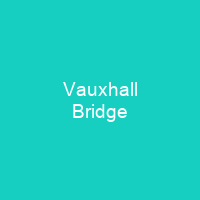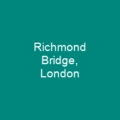Vauxhall Bridge: A Tale of Steel, Stone, and Time
Imagine stepping back into the heart of London’s history, where the River Thames flows like a silent witness to centuries of change. Vauxhall Bridge stands as a testament to this narrative, a Grade II* listed steel and granite deck arch bridge that has seen it all—royal processions, industrial revolutions, and even wartime fears.
The Birth of an Icon
So, how did such a grand structure come into being? In the early 19th century, when London was expanding rapidly, the need for better transportation across the Thames became pressing. The Vauxhall Bridge Act 1809 paved the way for a new bridge to be built, but financial troubles and design changes meant that it took until 1816 before John Rennie’s seven-arch stone bridge finally opened its doors.
A New Era of Steel
Fast forward to 1906, when the current Vauxhall Bridge was constructed. This time, steel replaced stone, and the bridge became a marvel of engineering. The design by John Wolfe Barry and Sir Thomas McCall featured monumental bronze statues on its piers, adding an artistic touch that made it not just functional but also a symbol of progress.
From Toll to Free
The transition from tolls to free passage was a significant shift in the bridge’s history. The Metropolis Toll Bridges Act 1877 allowed for the removal of tolls, making Vauxhall Bridge accessible to all Londoners. This change not only improved mobility but also contributed to the economic growth of the area.
War and Beyond
During World War II, Vauxhall Bridge faced its own challenges. A temporary steel bridge was built nearby due to fears that it might be targeted by bombers. Post-war, plans for a new Crystal Span bridge were abandoned, leaving the original structure standing strong.
Modern Marvels
In recent years, Vauxhall Bridge has undergone further transformations. The addition of Cycle Superhighway 5 and the removal of an extra traffic lane in favor of a cycle track reflect the city’s commitment to sustainable transport. Today, it remains a vital part of London’s road system, carrying not just vehicles but also dreams and aspirations.
A Legacy of Innovation
From its humble beginnings as a stone bridge to its current status as a steel marvel, Vauxhall Bridge has seen the evolution of engineering and urban planning. Its story is one of resilience, innovation, and adaptation—much like London itself.

Vauxhall Bridge is more than just a bridge; it’s a living, breathing part of London’s history. As we continue to build and rebuild, let us remember the lessons of the past and strive for a future that honors both progress and heritage.
You want to know more about Vauxhall Bridge?
This page is based on the article Vauxhall Bridge published in Wikipedia (retrieved on December 1, 2024) and was automatically summarized using artificial intelligence.







